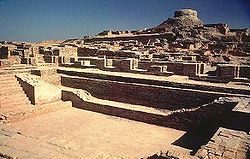
Great Bath, Mohenjo-daro
Encyclopedia

Indus Valley Civilization
The Indus Valley Civilization was a Bronze Age civilization that was located in the northwestern region of the Indian subcontinent, consisting of what is now mainly modern-day Pakistan and northwest India...
at Mohenjo-daro
Mohenjo-daro
Mohenjo-daro is an archeological site situated in what is now the province of Sindh, Pakistan. Built around 2600 BC, it was one of the largest settlements of the ancient Indus Valley Civilization, and one of the world's earliest major urban settlements, existing at the same time as the...
in Sindh
Sindh
Sindh historically referred to as Ba'ab-ul-Islam , is one of the four provinces of Pakistan and historically is home to the Sindhi people. It is also locally known as the "Mehran". Though Muslims form the largest religious group in Sindh, a good number of Christians, Zoroastrians and Hindus can...
, Pakistan
Pakistan
Pakistan , officially the Islamic Republic of Pakistan is a sovereign state in South Asia. It has a coastline along the Arabian Sea and the Gulf of Oman in the south and is bordered by Afghanistan and Iran in the west, India in the east and China in the far northeast. In the north, Tajikistan...
. It is located in the well-preserved northern part of Mohenjo-daro's western mound, which is also known as the "Mound of the Great Bath" or the "citadel".
Archaeological evidence indicates that the Great Bath was built in in the 3rd century BCE, just sometime after raising of the mound on which it is located. It was no longer in use during the last phases of the Late Period of the civilization. It was discovered during 1925-26.
The Great Bath measures 11.88 metres x 7.01 metres, and has a maximum depth of 2.43 metres. Two wide staircases, one from the north and one from the south, served as the entry to the structure. The Great Bath is built of fine baked bricks lined with bitumen (presumably to keep water from seeping through), which indicates that it was used for holding water. Many scholars have suggested that it could have been a place for ritual bathing or religious ceremonies, but the actual use remains a mystery.Some say it was used to purify the soul in ancient South Asia.

